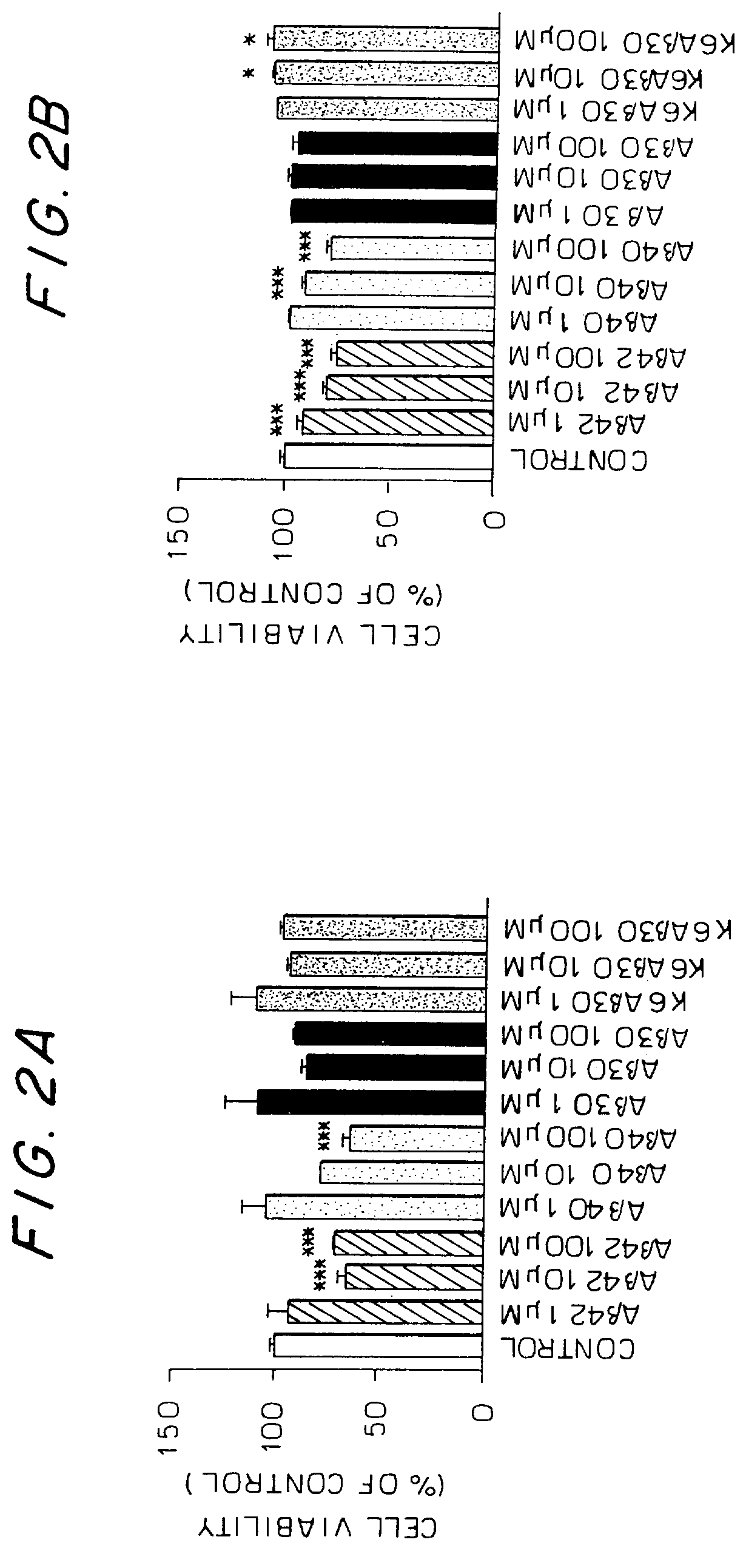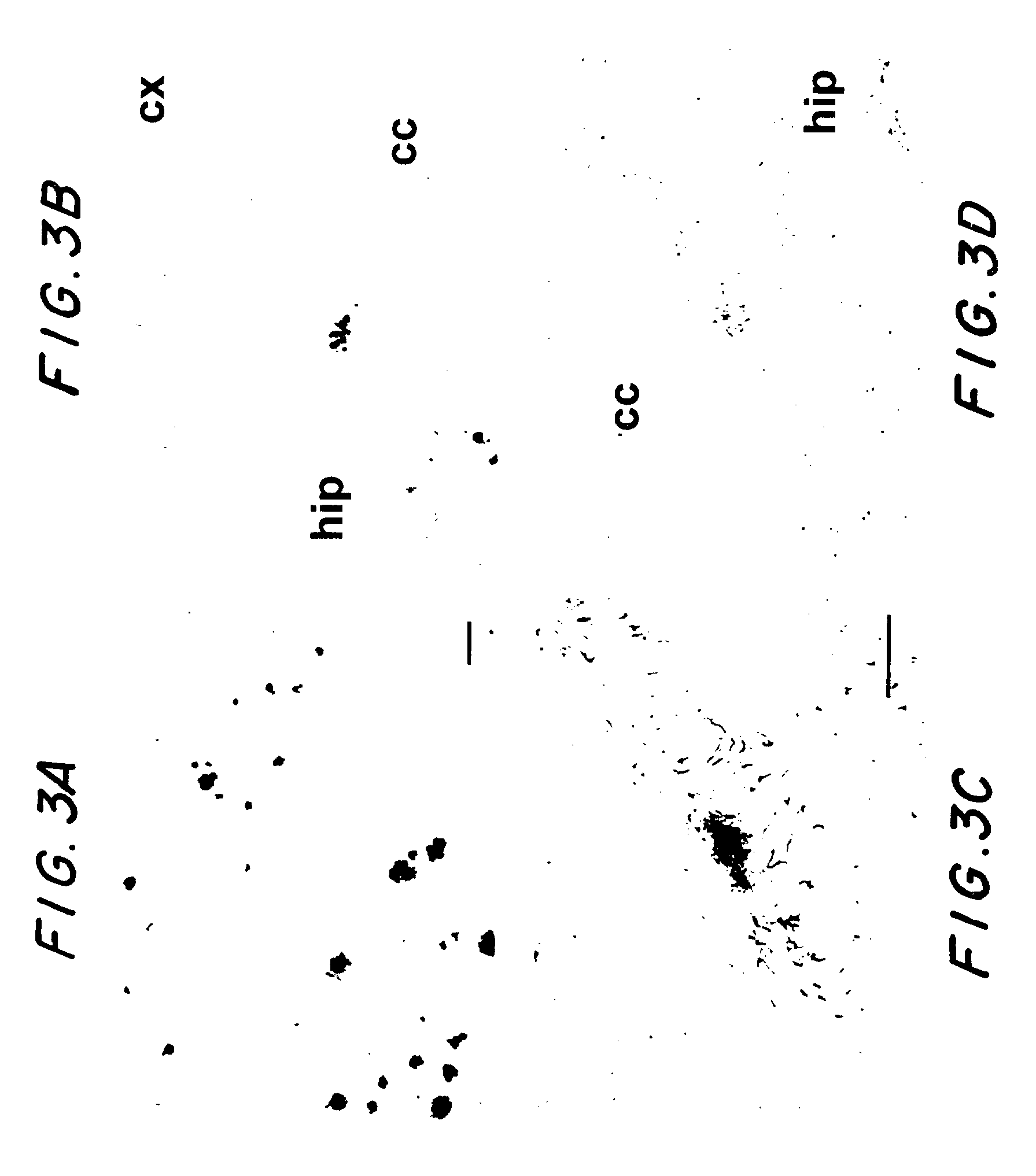Synthetic immunogenic but non-deposit-forming polypeptides and peptides homologous to amyloid beta, prion protein, amylin, alpha-synuclein, or polyglutamine repeats for induction of an immune response thereto
a polypeptide, non-deposit-forming technology, applied in the direction of peptide sources, antibody medical ingredients, metabolism disorders, etc., can solve the problems of reducing the burden of amyloid in patients, no cure or effective therapy for reducing the burden of amyloid, and most potent compound
- Summary
- Abstract
- Description
- Claims
- Application Information
AI Technical Summary
Benefits of technology
Problems solved by technology
Method used
Image
Examples
example 1
[0202]The experiments in this example demonstrate that immunization in transgenic APP mice (Tg2576) for 7 months with a non-amyloidogenic, non-toxic Aβ homologous peptide reduced cortical and hippocampal brain amyloid burden by 89% (p=0.0002) and 81% (p=0.0001), respectively. Concurrently, brain levels of soluble Aβ1-42 were reduced by 57% (p=0.0019). Ramified microglia expressing interleukin-1β associated with the Aβ plaques were absent in the immunized mice indicating reduced inflammation in these animals. The materials and methods used in the experiments in this example and the experimental results are presented below.
Materials and Methods
Peptides
[0203]The peptides used (Aβ1-40, Aβ1-42, Aβ1-30-NH2 (SEQ ID NO:1), and K6Aβ1-30-NH2 (SEQ ID NO NO:6)) were synthesized at the Keck Foundation (Yale University, New Haven, Conn.), as described previously (Sigurdsson et al., 2000). Non-amyloidogenic peptides according to the present invention are synthesized using solid-phase tBOC (N-tert-...
example 2
Materials and Methods
Peptides
[0239]The peptides used (Aβ1-40, Aβ1-42, Aβ1-30-NH2, K6Aβ1-30-NH2, Aβ1-30-K6 (SEQ ID NO:11), Aβ1-30-NH2(EE18,19) (SEQ ID NO:12), Aβ1-30-NH2(DD18,19) (SEQ ID NO:13) were synthesized at the Keck Foundation (Yale University, New Haven, Conn.), as described previously (Sigurdsson et al., 2000). The Aβ homologous peptides maintain the two major immunogenic sites of Aβ peptides (residues 1-11 and 22-28 of Aβ1-42 based on the antigenic index of Jameson et al. (1998) and on preliminary results obtained in the laboratory of the present inventors), while being non-fibrillar and non-toxic.
Study of Amyloid Fibril Formation in vitro and Neurotoxicity
[0240]The experiments were performed as described in Example 1.
[0241]Data Analysis: The cell culture data was analyzed by one-way ANOVA, followed by a Newman Keuls' test for post hoc analysis (GraphPad Prism 3.0).
Results
[0242]Thioflavin T assay: Aβ1-42 was already fibrillar at t=0, whereas Aβ1-30-NH2 and Aβ1-40 gradually ...
example 3
[0244]Prion infections do not illicit a classical immune response; however, transport of prions from the periphery to the central nervous system is critically dependent on the lymphoreticular system. In this example, the present inventors sought to determine how active immunity against PrP would influence progression of disease. The experiments described herein show that vaccination with recombinant mouse prion protein (recPrP) delays the onset of prion disease in mice.
Methods
[0245]Twenty female CD-1 mice, 2-3 months of age, were immunized with mouse recPrP. For the first injection, the recPrP (Brown et al., 1999) (1 mg / ml in 0.5 M urea) was mixed with an equal volume of complete Freund's adjuvant immediately before subcutaneous administration (50 μg recPrP / 100 μl). Twenty control mice received the adjuvant plus vehicle. Subsequent immunizations were performed at 2 weeks intervals in incomplete Freund's adjuvant. Fourteen weeks following the first vaccination the mice were bled and ...
PUM
| Property | Measurement | Unit |
|---|---|---|
| Time | aaaaa | aaaaa |
| Time | aaaaa | aaaaa |
| Time | aaaaa | aaaaa |
Abstract
Description
Claims
Application Information
 Login to View More
Login to View More - R&D
- Intellectual Property
- Life Sciences
- Materials
- Tech Scout
- Unparalleled Data Quality
- Higher Quality Content
- 60% Fewer Hallucinations
Browse by: Latest US Patents, China's latest patents, Technical Efficacy Thesaurus, Application Domain, Technology Topic, Popular Technical Reports.
© 2025 PatSnap. All rights reserved.Legal|Privacy policy|Modern Slavery Act Transparency Statement|Sitemap|About US| Contact US: help@patsnap.com



